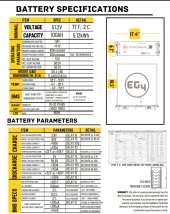I think the whole argument that the customer bought the battery based on this spec is a load of crap and being exploited now. The inverter does NOT SPEC that running this particular vacuum mentioned in this thread would require a 250a 1s surge from the battery. It's not a real spec from the inverter! The real specs the inverter DOES have have been ignored...
Here's the spec, what battery is supposed to do:
100A constant discharge
>100A, 10 second delay
>150A, 3 second delay
>250A, 1 second delay
An inverter application is expected to have varying continuous draw, and surge capability. Many inverters spec surge of 2x nominal, so 5kW inverter might deliver 10kW. From a 48V battery, that would be 200A or so. If surge goes away within one second, this battery's spec indicates should be OK. If multiple seconds, this battery is expected to shut off. If surge is under about 7kW, draw on battery would be < 150A, should be fine for at least 3 seconds, maybe 10 seconds, should be OK.
It doesn't seem like OP's < 1kW vacuum powered by 5kW inverter should exceed these current ratings.
It may be, with a poorly filtered high-frequency inverter, that there are millisecond pulses higher than 250A to synthesize 60 Hz sine wave.
Battery spec indicates that should be ignored, but if it actually disconnects in 0.1 milliseconds, that would be the "disconnect".
I don't think "server rack" batteries were designed for inverter applications, especially single phase. I think they were designed for 48VDC PDU in a rack of computer servers.
Not designed for this application, no wonder there are problems.
We read people install a different BMS and everything is hunky-dory.
You vendors of server rack batteries for alternative energy systems ought to be setting different parameters, swapping in a different BMS, or specifying performance of a modified product to your vendors.
Either that, or very clearly (and correctly) specifying actual performance of these batteries with caveats for the application. e.g. this battery can NOT provide any surge above rated continuous output. A 100 Ah 48V 100A battery is suitable for no larger than 2kW inverter (with 4kW surge). For a 5kW or 6kW inverter, buy at least 3 batteries and connect in parallel.









